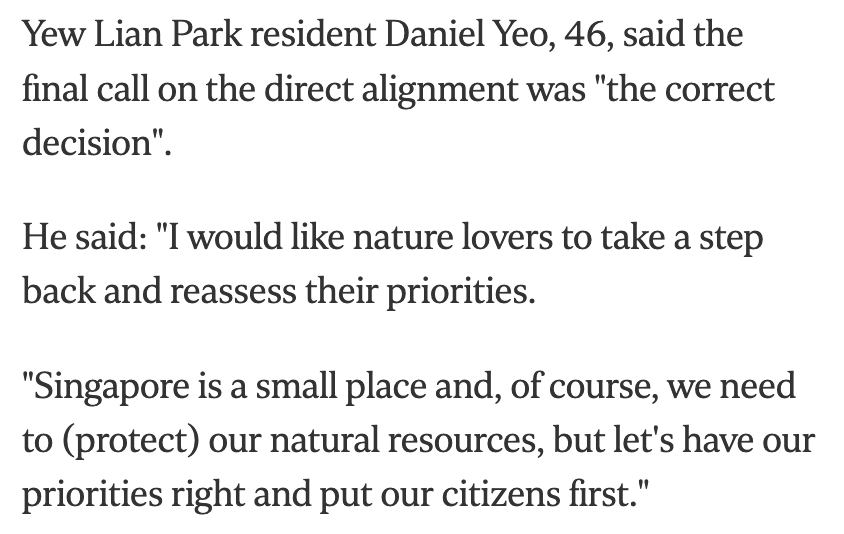I can’t believe it’s December already. Soon everyone will be taking stock of 2019 and planning for 2020 and I’m not ready; I feel like we’ve barely had time to breathe this year!
This year, I started the Milo Peng Fund as a way for people to financially support this newsletter—thank you to all my current Milo Peng Funders! And since the holiday month is upon us, I’ve created my first ever special offer for this newsletter. It gives you a 30-day free trial, which means you’ll also get the extra emails that are exclusive to Milo Peng Funders. Just click this link (or the button below) to get started—you have to redeem this offer by 31 December 2019!
A decision made about the (cutting ac)Cross Island Line
One morning in 2016 I woke up at the crack of dawn and made my way to the Central Catchment Nature Reserve to join the Love Our MacRitchie Forest campaign volunteers on walk. At the time, they were conducting these guided walks every two weeks to educate people on the importance of the nature reserve and its biodiversity. They hoped that this would feed into their efforts to convince the government not to have the planned Cross Island MRT line cut through (albeit underground) the nature reserve, but to skirt it instead. My early morning walk with them led to this feature; I tried to keep an eye on the issue after but it seemed to die down after some time and got overtaken by breaking news and assorted social media uproars.
The government has now made a decision: the line will run under the nature reserve. But it’ll run 70m under, instead of the usual 20–30m underground. This means that there will be no surface works done in the reserve. This, of course, pleases the people living in landed property around the nature reserve, since they were worried that there might be land acquisition and disruption from construction if the skirting option had been chosen. Although I see quotes like this…

…and it’s like, “Dude, do you want people to dislike you?”
But Daniel Yeo, 46, aside, nature groups are still concerned about the impact of building this line. While they appreciate that some concessions have been made, they’re worried that the mitigation measures might not be fail-safe and that this could set a precedent for future development. Experts are also afraid that the planned MRT line will affect the critically endangered Raffles banded langur, a species of primate native to Singapore, because an above-ground worksite could cut their habitat and divide the already-small population.
The never-ending minefield of the interwebs
Last week I looked at the first three uses of POFMA. There’s been a bit more reaction to it since, including my own for Lowy Institute’s The Interpreter. The government has also come out to justify the order against Brad Bowyer’s Facebook post, and not everyone is alarmed by the recent use of the law: while some point to confusion over fact vs opinion, others say that the use of correction notices—as opposed to demands to take down content—means that free speech hasn’t been curbed.
I’d like to take on this argument that correction notices don’t curb free speech, but don’t want to make this email too long, so I’ll be writing it in a separate post, which you’ll be able to find here (Milo Peng Funders, it’s been emailed to you for your reading convenience).
Also, I did a highly unscientific straw poll on Twitter (click on the tweet below to see the results):
POFMA isn’t the only thing that’s causing angst online, though. The Singapore Democratic Party has questioned Google’s decision to ban political advertising in Singapore.
I’m not sure if Google properly understands Singapore’s political climate and landscape if they think this ban is just fair and square. As Cherian points out in his tweet above, such a ban would affect opposition parties, while the PAP will get to push its message framed as “public service” or “government announcements”. This is the reality everywhere: opposition parties aren’t allowed onto private property without invitation from residents, while the PAP can do meet-and-greets under the guise of explaining government policies. The same goes for schools and universities: it would be partisan politics if opposition politicians went to give talks or seminars, but PAP ministers and MPs are able to go all the time. And the PAP also has influence and control over the mainstream media—the playing field is already so skewed, and this ban on political advertising is tilting it even further.
I get the concern about political advertising and election interference and the spread of misinformation, and I have a lot of sympathy for the policy folk in these giant tech companies trying to figure stuff out, but policies really need to respond to the specific contexts in which they are meant to operate.

We opened December with our latest comic explainer, this time answering the question: What is Democracy? Please share this widely!
We also published this story on domestic violence in Timor-Leste, and how there is now precedent to punish abusers.
Finally, we have a piece on the relationship between leftist youth activists and the Philippine state. “Strained” is a very conservative way of putting it.
You’ll notice that you’re able to access all our pieces through these links despite the fact that New Naratif has a paywall on our site. That’s because every New Naratif member has a unique URL that allows them to share articles with anyone they want, as many times as they want. It’s our way of balancing the need to remind people that such content needs to be paid for, while not barring anyone’s access to important information and research.

